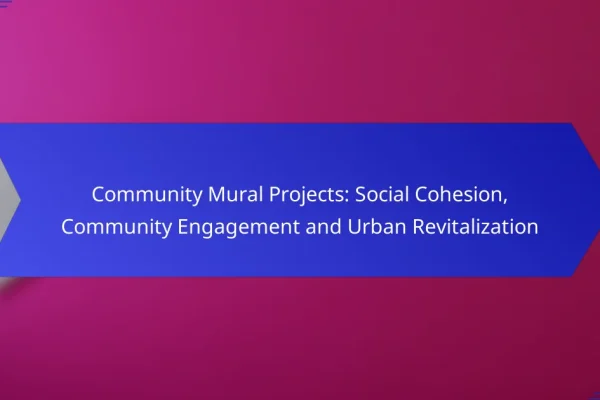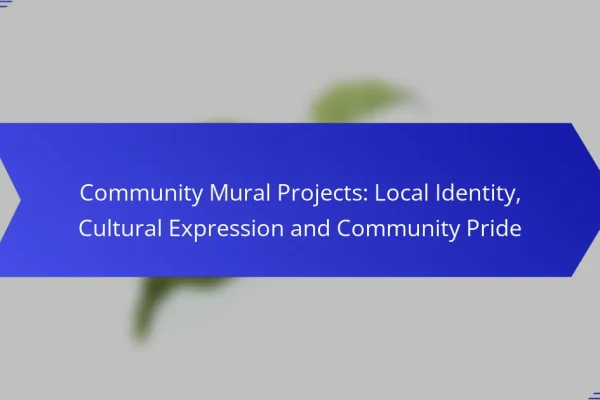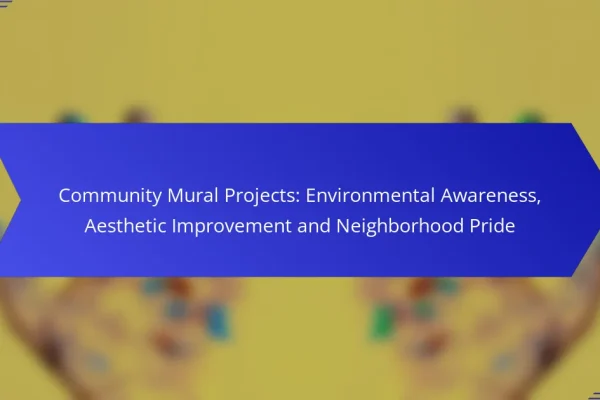How do community mural projects enhance local identity?
Community mural projects enhance local identity by visually representing the unique characteristics and values of a neighborhood. These murals often incorporate local history, culture, and community narratives, fostering a sense of pride and belonging among residents.
Strengthening community bonds
Community mural projects bring people together, encouraging collaboration among residents, artists, and local organizations. This teamwork helps build relationships and fosters a sense of unity as individuals work towards a common goal.
Engaging in the mural creation process can lead to increased social interaction, which strengthens ties within the community. Events like mural painting days or unveiling ceremonies can further enhance these connections.
Reflecting cultural heritage
Murals often serve as a canvas for expressing the cultural heritage of a community. They can depict significant historical events, traditional practices, or local legends, allowing residents to celebrate their roots and educate others.
By incorporating diverse cultural elements, murals can promote inclusivity and appreciation for different backgrounds, enriching the community’s overall identity. This reflection of heritage can attract visitors, boosting local tourism and economy.
Promoting local artists
Community mural projects provide a platform for local artists to showcase their talents and gain recognition. This exposure can lead to further opportunities, such as commissions or collaborations with businesses and organizations.
Supporting local artists through mural projects can also stimulate the local economy, as artists may purchase supplies and services from nearby businesses. Additionally, these projects can inspire aspiring artists in the community, fostering a vibrant creative environment.
What are the economic benefits of community mural projects?
Community mural projects offer significant economic benefits by enhancing local visibility, attracting visitors, and increasing property values. These projects can create a vibrant atmosphere that encourages spending and investment in the area.
Increasing local business visibility
Murals can serve as eye-catching landmarks that draw attention to nearby businesses. By incorporating local themes and branding, these artworks can help businesses stand out in a crowded marketplace.
For instance, a mural featuring local history can attract passersby who may not have otherwise noticed a small café or boutique. This increased visibility can lead to higher foot traffic and, subsequently, increased sales.
Attracting tourism
Community murals can become tourist attractions, drawing visitors who seek unique experiences and photo opportunities. Cities with notable murals often see an uptick in tourism, as people travel to see these artistic expressions.
For example, cities like Berlin and Buenos Aires have successfully leveraged street art to boost their tourism industries. Local governments can promote mural tours, enhancing the economic impact of these projects.
Boosting property values
Well-executed mural projects can enhance the aesthetic appeal of neighborhoods, leading to increased property values. Homes and commercial properties near vibrant murals often see appreciation due to the improved environment.
Real estate studies indicate that properties in areas with public art can experience value increases ranging from several percentage points to over ten percent. This trend makes community murals a worthwhile investment for local stakeholders.
How do community mural projects improve public spaces?
Community mural projects enhance public spaces by transforming dull or neglected areas into vibrant, engaging environments. These initiatives foster a sense of ownership and pride among residents, leading to improved community cohesion and interaction.
Transforming neglected areas
Community murals can revitalize underused or abandoned spaces, turning them into focal points for the neighborhood. For example, a once-derelict wall can become a canvas for local artists, attracting foot traffic and encouraging local businesses to thrive.
When planning a mural, consider the location’s history and community input to ensure the artwork resonates with local residents. This approach not only beautifies the area but also instills a sense of belonging and pride among community members.
Encouraging community engagement
Mural projects often involve local residents in the design and painting process, fostering collaboration and dialogue. Workshops and community meetings can be organized to gather input and ideas, ensuring that the mural reflects the collective identity of the area.
Engagement can extend beyond the mural’s creation; ongoing events, such as mural unveilings or art walks, can further strengthen community ties. These activities encourage participation and create opportunities for residents to connect with one another.
Enhancing aesthetic appeal
Murals significantly enhance the visual appeal of public spaces, making them more inviting and enjoyable. A well-executed mural can transform a bland wall into a stunning piece of art, attracting visitors and enhancing the overall atmosphere of the area.
Consider incorporating elements that reflect local culture or history to create a deeper connection with the community. This not only beautifies the space but also educates viewers about the area’s heritage, making the mural a source of pride for residents.
What are the social impacts of community mural projects?
Community mural projects have significant social impacts, enhancing local identity and fostering a sense of belonging among residents. These initiatives often bring together diverse groups, creating a shared space for expression and collaboration.
Fostering inclusivity
Community murals can serve as a platform for underrepresented voices, allowing individuals from various backgrounds to contribute to the artistic process. This inclusivity can help bridge cultural divides and promote understanding among different community members.
In practice, involving local artists and residents in the mural creation process encourages participation and ownership. Organizing workshops or open calls for design submissions can enhance community engagement and ensure diverse perspectives are represented.
Encouraging dialogue
Mural projects often spark conversations about important social issues, encouraging community members to engage in dialogue. By depicting themes relevant to local experiences, murals can serve as conversation starters that address topics such as identity, history, and social justice.
To maximize dialogue, consider hosting community events or discussions around the mural’s themes. This can deepen understanding and foster connections among residents, transforming the mural into a catalyst for ongoing community engagement.
What are the environmental benefits of community mural projects?
Community mural projects offer significant environmental benefits by enhancing urban aesthetics and promoting sustainability. These initiatives can transform neglected spaces into vibrant areas that encourage community engagement and environmental awareness.
Promoting green spaces
Community murals can be strategically placed in parks or along urban walls, effectively integrating art with nature. By beautifying these spaces, murals can attract more visitors, encouraging the preservation and maintenance of green areas. This increased foot traffic often leads to community-led efforts to keep these spaces clean and thriving.
Incorporating murals into green spaces can also enhance biodiversity. For instance, murals featuring local flora and fauna can educate the public about native species and their importance, fostering a deeper connection to the environment.
Utilizing eco-friendly materials
Using eco-friendly materials in mural projects significantly reduces environmental impact. Artists can choose non-toxic paints, biodegradable adhesives, and sustainable substrates, which contribute to healthier urban environments. Many communities now prioritize these materials to align with broader sustainability goals.
When planning a mural, consider sourcing materials locally to minimize transportation emissions and support local economies. Additionally, engaging with local artists who prioritize sustainability can further enhance the project’s environmental benefits, creating a sense of ownership and responsibility within the community.
How can communities fund mural projects?
Communities can fund mural projects through various methods, including grants, sponsorships, and crowdfunding initiatives. Each option offers unique advantages and considerations that can help bring artistic visions to life.
Grants and sponsorships
Grants and sponsorships are often the most reliable sources of funding for mural projects. Local governments, arts councils, and private foundations frequently offer grants specifically for community art initiatives. Sponsorships from local businesses can also provide financial support in exchange for promotional opportunities, enhancing community engagement.
When seeking grants, it’s essential to research eligibility criteria and application deadlines. Many grants require a detailed project proposal, including a budget and timeline. For sponsorships, building relationships with local businesses can lead to mutually beneficial partnerships that support the mural’s creation and visibility.
Crowdfunding initiatives
Crowdfunding initiatives allow communities to raise funds directly from individuals who support the mural project. Platforms like Kickstarter or GoFundMe can be effective for gathering small contributions from a large number of people. This approach not only raises funds but also fosters community involvement and excitement around the project.
To run a successful crowdfunding campaign, clearly outline the project’s goals, budget, and timeline. Offering incentives, such as exclusive merchandise or recognition on the mural, can motivate potential backers. It’s crucial to promote the campaign through social media and local events to reach a wider audience and achieve funding targets.
What are successful examples of community mural projects in the US?
Successful community mural projects in the US often involve collaboration between local artists, residents, and organizations to create vibrant public artworks that reflect the community’s identity. Notable examples include the Philadelphia Mural Arts Program and the Wynwood Walls in Miami, which have transformed neighborhoods and fostered community pride.
Philadelphia Mural Arts Program
The Philadelphia Mural Arts Program is one of the largest public art programs in the country, featuring thousands of murals across the city. It engages local residents in the design and creation process, ensuring that the artwork resonates with the community’s history and culture. This program not only beautifies neighborhoods but also serves as a tool for social change and community engagement.
Wynwood Walls in Miami
Wynwood Walls is an outdoor museum of street art located in Miami’s Wynwood Arts District. It showcases large-scale murals by renowned artists from around the world, attracting tourists and art enthusiasts alike. The project revitalized a previously neglected area, turning it into a vibrant cultural hotspot that supports local businesses and fosters community interaction.
Community Engagement and Impact
Community mural projects often lead to increased local engagement and pride. By involving residents in the creative process, these projects can strengthen community bonds and encourage collaboration among diverse groups. Additionally, murals can serve as a platform for addressing social issues, promoting dialogue, and fostering a sense of belonging.
Funding and Resources
Securing funding is crucial for the success of community mural projects. Potential sources include local government grants, private donations, and crowdfunding campaigns. Artists and organizers should consider applying for grants specifically aimed at public art initiatives, as well as partnering with local businesses for sponsorship opportunities.
Challenges and Considerations
While community mural projects can be highly beneficial, they also come with challenges. Issues such as zoning regulations, property rights, and community opposition can arise. It’s essential to engage stakeholders early in the process to address concerns and ensure that the project aligns with community values and goals.












